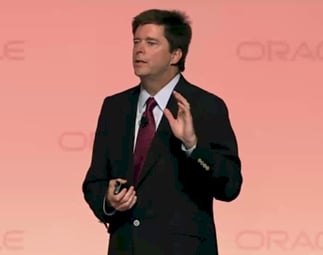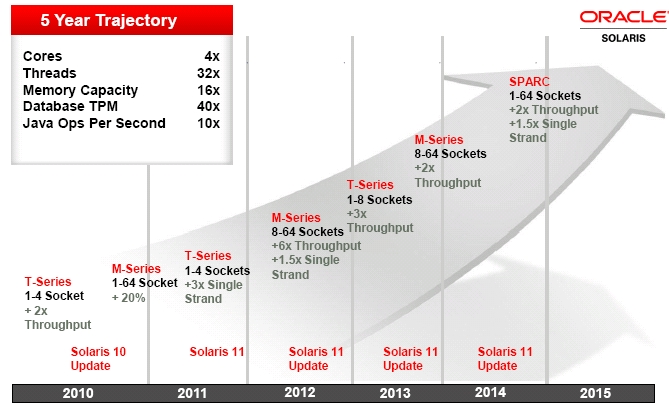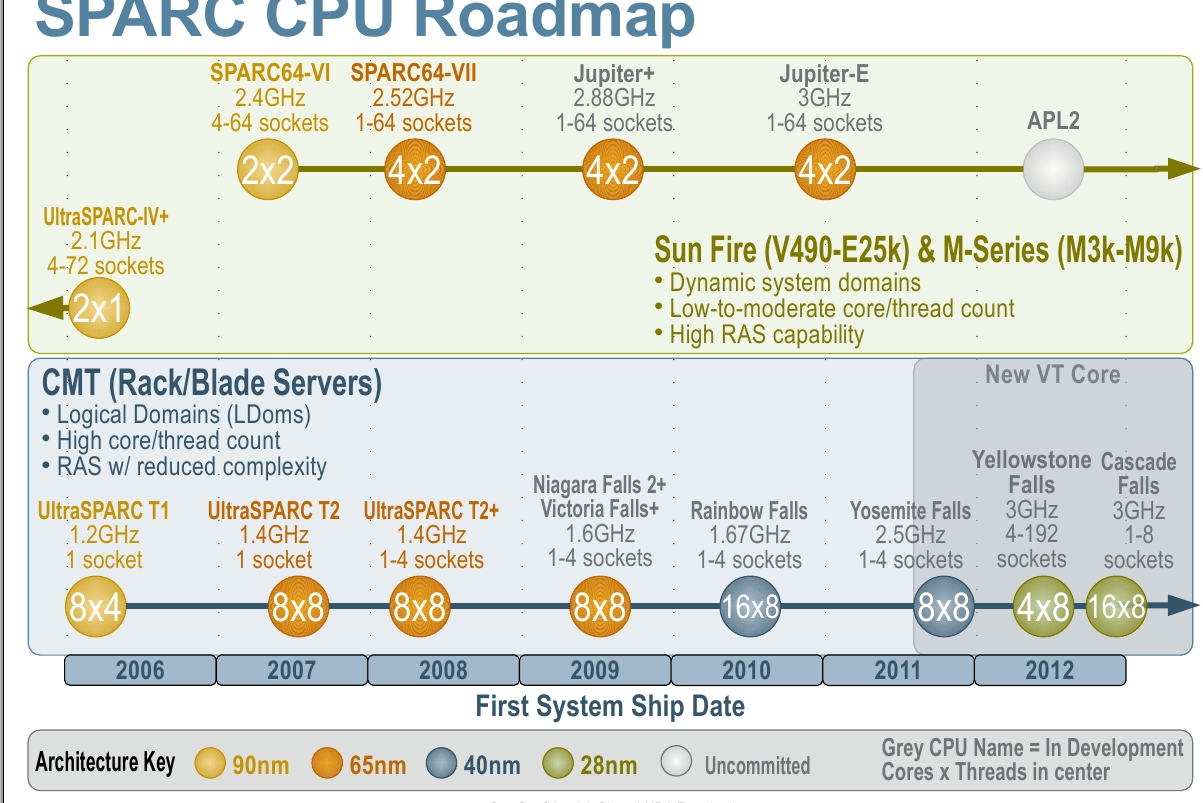Original URL: https://www.theregister.com/2011/09/29/oracle_revised_sparc_roadmap/
Oracle revs up Sparc, speeds up roadmap
Years to go before Larry dumps x86 and Sparc64
Posted in Channel, 29th September 2011 19:30 GMT
How long will it be until Oracle stops selling systems that are based on Intel's Xeon processors? Or servers that use Fujitsu's Sparc64 line of processors, for that matter?
To hear Oracle cofounder and CEO Larry Ellison tell it, tomorrow would be just fine to cease and desist making and selling x86-based machinery. The only problem is that a lot of Oracle's software – particularly the Exadata storage servers that are part of its Exadata parallel database clusters – is tuned for Linux and the relatively high clock speeds and large cache memories of the x86 architecture.
While Oracle's new Sparc T4 processors announced this week go a long way towards closing the clock and cache gaps with both Xeon and Sparc64-VII+ processors, it is probably going to take a few more years before Oracle's systems are entirely Sparc-based.
That is, unless Oracle goes and does something silly such as buying HP, in which case all many Sparc roadmap bets would be off.

Oracle hardware chief John Fowler
And even if Oracle does eventually go all-Sparc for its homegrown iron, that will never mean that Oracle does not also sell its database, middleware, and application software on x86, Power, or mainframe processors. Oracle has, of course, dropped an iceberg in front of the Itanic, made by Intel almost exclusively for HP's HP-UX/Integrity systems, saying in March that it would not support its software on the future "Poulson" and "Kittson" Itaniums, due in 2012 and 2014, respectively.
HP, under former CEO Leo Apotheker, took Oracle to court, alleging that Ellison & Co. were harming its HP-UX business, and that the software giant was in breach of agreements to continue support for its software on Itanium platforms. Oracle will continue to support current generations of software on current Itaniums, but Oracle's move had a chilling effect on HP-UX server deals in its third quarter of fiscal 2011 ended in July.
Sun Microsystems was for many years the undisputed leader in Unix systems, back when the Unix market was roughly twice as large as it is today (in terms of revenues), the dot-com boom was boom-boom-booming, and Linux had not yet carved out a big slice of the data center market. But Sun had many self-inflicted wounds, with buggy, delayed, or canceled processors: UltraSparc-IIIs were late and had some cache bugs, and the "Millennium" UltraSparc-V and "Rock" UltraSparc-RK processors were killed shortly before coming to market.
Sun also had pricing that didn't meet the reality of a post-boom Main Street, leaving the door open for Big Blue to come in and snap up business with its Power-AIX combo. Now working at Oracle, the Sunners in charge of processors and systems cannot repeat the mistakes that the old Sun made. Even Larry Ellison can't afford to be that wrong.
In a commendable move last summer, Oracle's executive vice president of hardware engineering John Fowler put out a five-year Sparc processor and system roadmap, running out to 2015. It was a stake in the ground – rather than through Sun's heart as past roadmaps sometimes were – and a foundation for a new relationship with Sparc/Solaris customer, whose trust Oracle needs if it is to reap the billions in dollars in profits it hopes it can reap from its January 2010, $7.6bn acquisition of Sun.
"You cannot build a strong package out of a collection of weaker components," Fowler explained during the Sparc T4 processor and system launch earlier this week. "We understand that and here at Oracle we have been investing in Sparc and investing in Solaris to create these leadership technologies."
The big changes with the new Sparc T4 chip have to do with a new core, called S3, that features out-of-order execution, dynamic threading, fatter caches, and higher clock speeds – four things that were sorely needed to help boost the performance of the Sparc T line on single-threaded applications.
Fowler flashed up last year's Sparc roadmap, just to refresh everyone's memory:
"This is the exact slide that I published about a year ago, and I said, 'Here's my five-year roadmap for what we're doing in Sparc'," he said. "I remember at the time getting a rather muted response to that particular pronouncement because either most people don't publish microprocessor roadmaps or they publish ones that you don't believe because they don't actually happen. I am happy to say that this is what we're doing and this is what we're invested in."
That's a long-winded way of saying: Trust me.
The HotThreads era
"The major nodes of T4 are available now," Fowler said, "and it's faster than what we said publicly. It's much faster that what we said publicly. And where we are going in the Sparc roadmap is very active."
Being someone who has garbled more than a few sentences in my life, I will cut him slack and simply point out that I know what he meant. "We are very actively in test and have systems up and running along the next line of systems," he continued. "We've made some modifications to the roadmap. We've pulled in some of the upgrades to the T Series, and added another upgrade to the T Series, which we are going to go into some detail about in a future announcement."
So here's the revised Sparc processor roadmap:
As you can see when comparing the roadmaps, the new S3 cores are delivering a 5X performance increase on single-threaded work compared to the 3X that was promised, partly because of the out-of-order execution on the new S3 core, but also because of the larger L3 caches and the 3GHz clock speed of the top-bin Sparc T4 parts.
The CoolThreads era, where 1GHz to 1.65GHz clocks were the design point, is over. We are now in the HotThreads era.
The interesting change in the revised roadmap is that the kicker to the T Series chips, the Sparc T5, which was slated for delivery in early 2013 on last year's roadmap, has now been pulled into 2012.
On the old roadmap, this Sparc T5 chip was supposed to have three times the throughput as the Sparc T5 and the same single-thread (what Oracle calls "single strand") performance; it is aimed at machines with from one to eight Sparc T processor sockets. This chip looks like the "Cascade Falls" processor that Sun had on the roadmap with 16 of the S3 cores, which were called "VT" cores back in late 2009 when this roadmap came out:
On the new and improved Oracle Sparc roadmap, the Sparc T5 is now slated to deliver only 2.5X the throughput, not 3X, but it is coming to market considerably early –my guess is about six months, but it is hard to say from these roadmaps. That's not a big dip in performance and having it to market earlier on Taiwan Semiconductor Manufacturing Corp's 28 nanometer processes is more important than an extra 20 per cent oomph.
Time-to-market is everything for Oracle now, particularly if it wants to protect its Sparc base against the onslaught of IBM's Power Systems and the hordes of x86 vendors peddling Linux and Windows as an alternative to Sparc/Solaris.
The removal of support for future Oracle software releases on Itanium pretty much puts HP-UX in limbo, and if the situation gets bad enough and if IBM hasn't actually nailed down support contracts with Oracle, then it is reasonable to assume that Power gets unplugged next.
In any event, the Sparc T5 processors will go into testing in October. A kicker for the Fujitsu Sparc64-VII+ processors, with six times the throughput and 1.5 times the single-thread performance, is already in test. It is very likely that this is a variant of the eight-core "Venus" Sparc64-VIIIfx processor that is at the heart of the K supercomputer built for the Japanese government by Fujitsu. Those Sparc64-VIIIfx chips run at 2GHz – not very fast.
The latest Sparc64-VII+ processors used in the Sparc Enterprise M midrange and big iron boxes, announced in December 2010, top out at 3GHz with 12MB of L2 cache, 64KB of L1 data cache, and 64KB of L1 instruction cache.
The Sparc64-VIIIfx has L1 caches that are only 32KB each and only 5MB of L2 cache, but it moves two DDR3 main memory controllers onto the chip and doubles up the core count to eight. If you pushed the clock speeds up to 3.5GHz on this eight-core chip, you'd only get about a factor of 2.3 more performance out of the Sparc64-VIIIfx compared to the current Sparc64-VII+ chips. So it looks like Fujitsu is doing something different with whatever this future Sparc Enterprise M server chip.
Perhaps Fujitsu is plunking a fat L3 cache on the chip as well as cranking the clocks and doubling the cores?
Whatever is going on, Fowler said that a follow-on Sparc64 is on track for late 2013 or early 2014, and in that same timeframe Oracle has added a new Sparc T Series chip – we'll call it the Sparc T6 just so we can keep it straight – that will have more single-threaded performance and presumably faster clocks. This Sparc T6 will work in machines with one to eight processor sockets, and that is all that Oracle has said about it so far.
Beyond that, the future Sparc processor which will have 64 sockets with a total of 16,384 threads, will support 64TB of main memory, is on track for delivery in late 2014 or early 2015. This future Sparc, which significantly is called neither an M Series or a T Series chip in the presentations, is having its feature set defined now, says Fowler.
The whole Ellison enchilada
None of this, however, may be as important as the idea of accelerating specific Oracle software operations in future Sparc T Series chips. This is where the "engineered systems" value of Oracle's acquisition of Sun will start coming into play.
This hardware-software stack approach is something that IBM has been able to do for decades with its Power and mainframe processors, and that HP has largely lost the ability to do because Intel, not HP, controls the Itanium processors that run HP's HP-UX, NonStop, and OpenVMS platforms; HP doesn’t have its own operating systems for Xeon processors and is basically a Red Hat and Microsoft reseller.
Perhaps HP should have kept the PA-RISC chips and therefore control of its destiny?
"In future silicon designs," explained Fowler, "what we are now doing is looking at acceleration in native Oracle data types that underlie the database, in dramatically improving coherency for building clusters, for protecting memory for large in-memory applications, and so on.
"We are actively working across all parts of the engineering team and instead of only doing threads and cores and clocks and I/O – which we will do – we are now starting to embed core elements for the acceleration of enterprise software directly into the processor. This will give us tremendous amounts of capability as measured by performance, scalability, memory capacity, and so on."
Ultimately, Oracle is pitting its engineered systems and its control over software against the commodity x86 architecture and the ubiquity of Windows and Linux.
Guess which is stickier: enterprise applications and databases, or servers and their processors? Given that we all know companies will change servers way before they will change database and application software, what happens when the software vendor actually delivers tuned hardware for those applications and other hardware vendors can't without the cooperation of that software vendor?
I don't know for sure, but I think we are eventually going to find out. It may even involve more lawsuits than the HP-Oracle Itanium suit. ®


